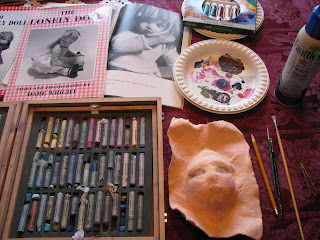How to Paint a Pressed Felt Face
 |
| Fig. 1, Pastel is applied to the face |
 |
| Fig. 2, The face is painted |
Once the face has been prepared as shown in the How to Mold a Pressed Felt Face post you are ready to begin painting. Start with the shading. I prefer Rembrandt soft pastels. Before you shade you will need to smooth down any flyaway wool filaments with starch. The book I have instructs you to use cooked starch (this is no longer available in the stores, so I Googled how to make starch); however, this is a long tedious process and doesn't work any better than heavy spray starch. Spray the starch on the eye, mouth, and cheek area and smooth the fibers down with your fingers. It is easier to let the starch dry and then apply the pastel, but if you do the shading when the felt is still damp it will set the pastel. If you shade when the felt is dry you can set the pastel afterward with starch or Crystal Clear. (Fig.1)
Grind the pastel into a palette and apply with a dry angled paintbrush. Apply beige shadow in the recessed eye area, such as along the eyelid crease and the corners of the eye to help the face appear more contoured. Then line the immediate eye area with light blue. Apply pink on the cheeks, chin, and nostrils. Look at your own face and see where you have pink areas and where your eyes are naturally shadowed. If you make a mistake you can "erase" it using a pastel the same tint as the felt. Blend a shade slightly lighter than the felt into the raised areas to give the face more relief.
When the starch is completely dry you can paint the face. If you are making a play doll for children it is probably better to use acrylic paint. Any good artist's paint is certified safe (look for the seal), but acrylic is easier to use and to clean later. The antique dolls are painted with oils, so if you are doing a collector doll and want that look use oil.
Use reference materials to start painting. For this doll I used the Lenci doll modified by Dare Wright for The Lonely Doll. Start with the whites of the eyes using pure white. Then shade the edges with Payne's Gray using a wet on wet technique. Next do the eye color. Use a lighter shade around the center of the eye and a darker shade along the edge of the iris. Be careful not too get eyes too bright so they look unrealistic. Even the bluest or greenest eyes have lots of other colors, like brown or yellow mixed in. I like to use colors that are not fully mixed when painting eyes. Do the pupil in Payne's Gray mixed with black next, and the highlights in pure white last. For the lashes line the eye with burnt umber mixed with yellow ochre and then pull the upper line up into lashes on the corners of the eye. Paint the brows with a series of dashes rather than one heavy line.
For the lips mix some crimson or red with sienna or burnt umber and white. Make the upper lip darker than the bottom lip. Highlight the center of the lower lip with white in a wet on wet technique. Mix blue and burnt umber with the lip color and paint the center lip line and corners.
The finished face will be ready to use as soon as the paint is dry. If you have concerns about durability you might want to seal the face with a coat of Crystal Clear. Be careful to retain the felt texture; don't apply too much. Your face is finished! (Fig. 2)


PanPastels may work perfectly instead of having to grind up pastels. They are really lovely to use. If you would like more information, I talk about it on my blog in respects to hand-shading teddy bears. http://www.binglebears.com/2011/10/wonders-of-panpastels.html
ReplyDeleteYou can buy them at Dick Blick's--I really can't recommend them enough.
Warmly,
Cheryl